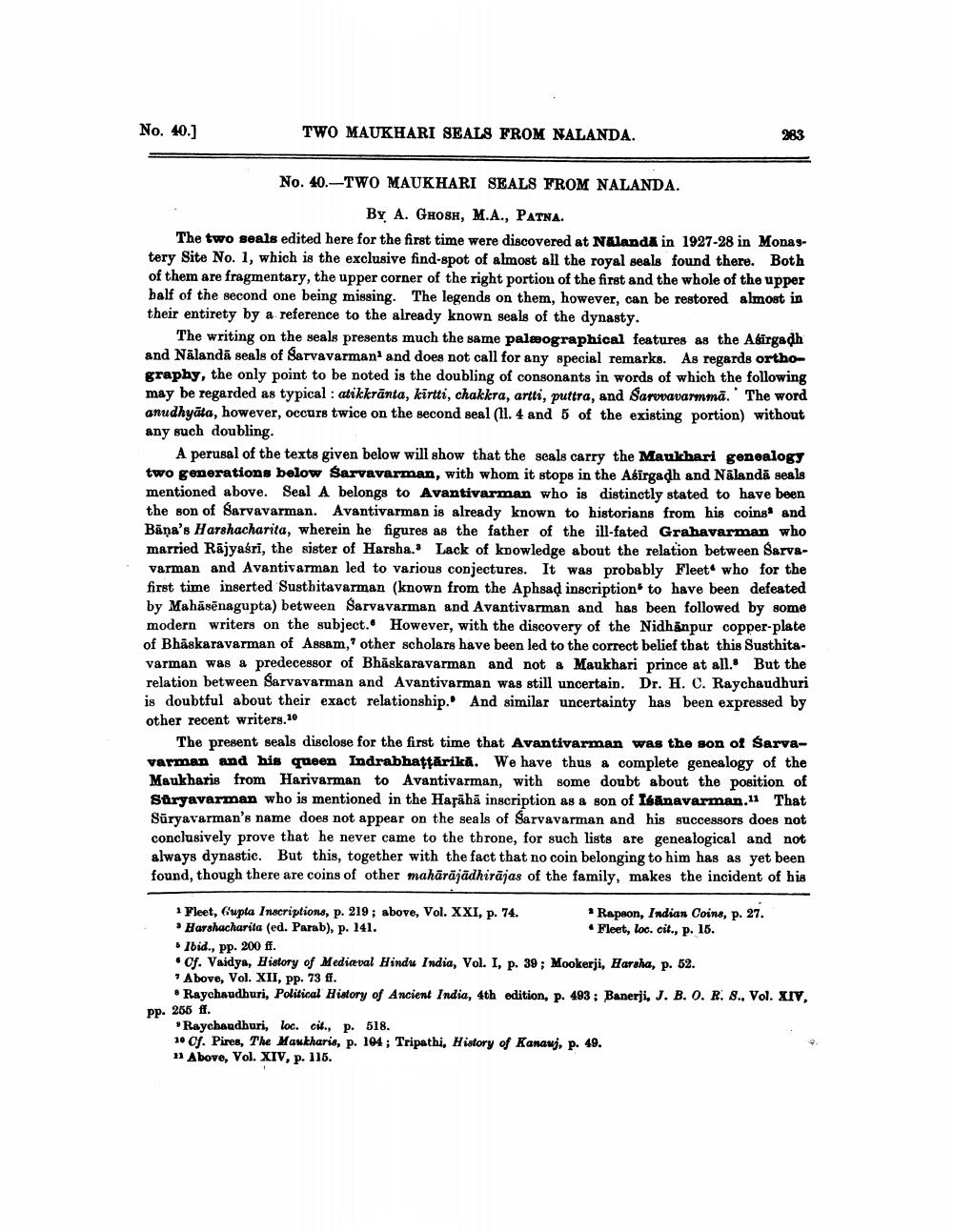________________
No. 40.]
TWO MAUKHARI SEALS FROM NALANDA.
No. 40.-TWO MAUKHARI SEALS FROM NALANDA.
By A. GHOSH, M.A., PATNA.
The two seals edited here for the first time were discovered at Nalanda in 1927-28 in Monastery Site No. 1, which is the exclusive find-spot of almost all the royal seals found there. Both of them are fragmentary, the upper corner of the right portion of the first and the whole of the upper half of the second one being missing. The legends on them, however, can be restored almost in their entirety by a reference to the already known seals of the dynasty.
The writing on the seals presents much the same paleographical features as the Asirgadh and Nālandā seals of Sarvavarman1 and does not call for any special remarks. As regards orthography, the only point to be noted is the doubling of consonants in words of which the following may be regarded as typical: atikkrānta, kirtti, chakkra, artti, puttra, and Sarvvavarmmā. The word anudhyāta, however, occurs twice on the second seal (11. 4 and 5 of the existing portion) without any such doubling.
A perusal of the texts given below will show that the seals carry the Maukhari genealogy two generations below Sarvavarman, with whom it stops in the Asirgadh and Nālandā seals mentioned above. Seal A belongs to Avantivarman who is distinctly stated to have been the son of Sarvavarman. Avantivarman is already known to historians from his coins and Bana's Harshacharita, wherein he figures as the father of the ill-fated Grahavarman who married Rajyaśrī, the sister of Harsha. Lack of knowledge about the relation between Sarvavarman and Avantivarman led to various conjectures. It was probably Fleet who for the first time inserted Susthitavarman (known from the Aphsaḍ inscription to have been defeated by Mahāsēnagupta) between Sarvavarman and Avantivarman and has been followed by some modern writers on the subject. However, with the discovery of the Nidhanpur copper-plate of Bhaskaravarman of Assam, other scholars have been led to the correct belief that this Susthitavarman was a predecessor of Bhaskaravarman and not a Maukhari prince at all. But the relation between Sarvavarman and Avantivarman was still uncertain. Dr. H. C. Raychaudhuri is doubtful about their exact relationship. And similar uncertainty has been expressed by other recent writers.10
283
The present seals disclose for the first time that Avantivarman was the son of Sarvavarman and his queen Indrabhaṭṭārikā. We have thus a complete genealogy of the Maukharis from Harivarman to Avantivarman, with some doubt about the position of Süryavarman who is mentioned in the Harāhā inscription as a son of Isanavarman." That Suryavarman's name does not appear on the seals of Sarvavarman and his successors does not conclusively prove that he never came to the throne, for such lists are genealogical and not always dynastic. But this, together with the fact that no coin belonging to him has as yet been found, though there are coins of other mahārājādhirājas of the family, makes the incident of his
1 Fleet, Gupta Inscriptions, p. 219; above, Vol. XXI, p. 74.
* Harshacharita (ed. Parab), p. 141.
Rapson, Indian Coins, p. Fleet, loc. cit., p. 15.
27.
Raychaudhuri, loc. cit., p. 518.
10 Of. Pires, The Maukharis, p. 104; Tripathi, History of Kanauj, p. 49.
11 Above, Vol. XIV, 115.
p.
5 Ibid., pp. 200 ff.
Cf. Vaidya, History of Mediaval Hindu India, Vol. I, p. 39; Mookerji, Harsha, p. 52. "Above, Vol. XII, pp. 73 ff.
*Raychaudhuri, Political History of Ancient India, 4th edition, p. 493; Banerji, J. B. O. R. S., Vol. XIV, pp. 255 ff.




